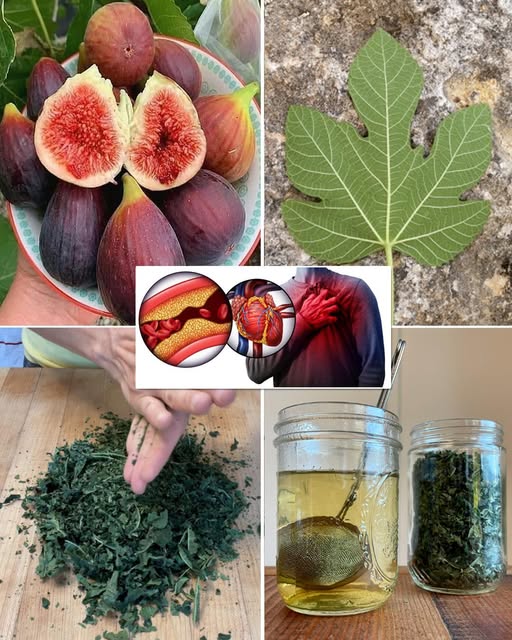The fig tree (Ficus carica) is widely recognized for its sweet fruit, but its leaves also offer an incredible range of benefits that are often overlooked. Used for centuries in traditional medicine, fig leaves are rich in nutrients and therapeutic compounds. From managing blood sugar to improving digestion and skin health, these leaves are a natural remedy with a surprising number of uses.

Nutritional Profile of Fig Leaves
Fig leaves are loaded with essential nutrients that support various aspects of health. They provide a healthy dose of vitamin A, B1, and B2, which play important roles in cellular repair, skin wellness, and energy production. Their mineral content includes calcium, magnesium, potassium, and phosphorus—key players in bone strength and muscle function. They’re also high in dietary fiber for digestive health and contain antioxidants like flavonoids and phenols that fight inflammation and oxidative damage.
Health Benefits of Fig Leaves
- Regulates Blood Sugar Levels
Fig leaves have been used as a natural way to help control diabetes. They work by improving insulin sensitivity and reducing blood glucose levels. Drinking fig leaf tea regularly is a common traditional method for managing type 2 diabetes. - Supports Heart Health
Fig leaves can help reduce LDL (bad cholesterol) levels, contributing to overall heart health. They’re also rich in potassium, which helps balance sodium in the body and maintain stable blood pressure levels. - Improves Digestive Health
With a high amount of fiber, fig leaves help improve bowel movements and soothe inflammation in the gut. They can also provide relief for individuals dealing with conditions like IBS or chronic constipation. - Anti-Inflammatory Effects
Bioactive compounds in fig leaves offer natural anti-inflammatory benefits. Regular use may help ease joint pain, arthritis symptoms, or inflammation-related health issues. - Promotes Weight Management
Fig leaf tea supports weight loss efforts by boosting metabolism and helping reduce fat buildup. It’s a healthy addition to a balanced diet and active lifestyle. - Boosts Skin Health
Rich in antioxidants, fig leaves help combat premature aging by reducing wrinkles and protecting the skin from environmental stress. They’re also useful in calming skin conditions such as eczema, acne, or psoriasis. - Offers Respiratory Relief
For centuries, fig leaves have been used to ease respiratory problems like bronchitis and asthma. Inhaling steam from boiled fig leaves helps clear mucus and soothe the airways. - Enhances Bone Strength
Thanks to their calcium and potassium content, fig leaves help maintain healthy bones and may prevent issues like osteoporosis when consumed regularly.
Culinary Uses of Fig Leaves
Fig Leaf Tea
Boiling fresh or dried fig leaves for 5 to 10 minutes creates a calming herbal tea that supports digestion, regulates blood sugar, and promotes relaxation.
Food Wrapping
Fig leaves are used similarly to grape leaves in cooking. When wrapped around rice, meats, or fish and then steamed or baked, they infuse dishes with a mild, nutty, almost coconut-like flavor.
Flavor Enhancer
Infusing fig leaves in milk or cream creates a distinct aroma that works well in desserts like custards, panna cotta, or ice cream.
Cooking Oil Infusion
Adding fig leaves to olive oil creates a naturally flavored oil that can be used for marinades, dressings, or drizzling over grilled vegetables.
Traditional and Medicinal Uses
Topical Applications
Crushed fig leaves or their extracts can be applied to small wounds, cuts, or inflamed skin to speed up healing and reduce irritation. They can also be used for bug bites or rashes.
Hair and Scalp Treatments
In natural hair care, fig leaf extract is used to nourish the scalp and reduce dandruff, helping to improve hair health overall.
Detoxification
Drinking a decoction of fig leaves supports detox processes in the liver and kidneys, helping the body flush out toxins more efficiently.
How to Prepare Fig Leaves for Use
Drying
After washing fresh fig leaves, dry them in a shaded, ventilated space. Once dried, they can be crushed into powder for teas or used in poultices.
Extracts and Oils
Boiling fig leaves creates a concentrated extract that can be used both externally and internally, depending on the intended purpose.
Fresh Leaf Usage
Fresh fig leaves are best for wrapping food or infusing into liquids like milk or oil for culinary use.
Precautions When Using Fig Leaves
Some people may experience sensitivity to the milky latex that fig leaves release. This sap can irritate the skin, so it’s recommended to wash your hands after handling the leaves. Overconsumption of fig leaf tea or supplements can lead to digestive discomfort. Always follow dosage guidelines, and consult a healthcare professional before use if you are pregnant, breastfeeding, or managing chronic health conditions.
Growing and Harvesting Fig Leaves
Fig trees thrive in warm, sunny climates and are relatively low-maintenance. If you grow your own, harvest mature, healthy leaves and use them fresh or dry them for future use. Store dried leaves in an airtight container away from moisture and light.
Fig leaves are a highly versatile and nutrient-rich resource that can benefit your health in many ways. Whether brewed into tea, used in your cooking, or applied to the skin, fig leaves offer natural support for digestion, heart health, skin care, and more. Incorporating them into your lifestyle is a simple yet powerful way to enhance your overall well-being with a touch of nature’s wisdom.





